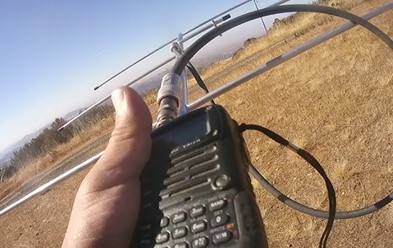Also known as fox hunting or radiosport, amateur radio direction finding (ARDF)is a sport that combines the use of ham radio gear, a topographic map, a magnetic compass, and orienteering skills. It is a timed race in which individual competitors or teams navigate through all kinds of terrain while searching for radio transmitters.
Direction finding originated in northern and eastern Europe in the late 1950s. Amateur radio was widely promoted in certain European schools as a modern technical and science activity. Most medium size and larger cities contained one or more amateur radio clubs where the members would gather and learn about the technology and operate the radio equipment. Direction finding and amateur radio were also promoted as important civil defense activities during the Cold War. Most people living in Europe at the time did not have personal automobiles, so most direction-finding activity took place on foot in parks, nature areas, or school campuses.
The transmitter used in direction finding is called a beacon. The beacon emits a weak radio signal. The tracker is a directional antenna and receiver used to find the beacon’s location.
The tracker looks like a television antenna with a little box called a sniffer. The sniffer lets you hear the beacon’s signal and determine the direction of the beacon from your current location. You can follow the tracker to the beacon or you can triangulate the signal. To triangulate the beacon, you plot the direction of the beacon at your current location on a map. You repeat the process at two other places sufficiently far apart so that the three lines plotted on the map form a triangle. That area within the triangle is the predicted location of the beacon.

So far we have described a fox hunt with only one hidden transmitter, or “fox.” World championships and international competitions have five low-power transmitters of 0.25 to 1 watt for 2m and 1 to 5 watts for 80m. Each transmits automatically and sequentially on the same frequency for one minute. Participants try to locate as many of them as possible and finish within the specified time. These rules are set by the International Amateur Radio Union (IARU).
The number of transmitters found and time taken to find them are considered in deciding the winner, though the priority is the number of transmitters found. Detailed orienteering maps are provided for plotting the location of the participant and the bearings of the foxes. Different competitions are held for 2m and 80m on different days. These bands are chosen because they have amateur allocations in almost all countries.
Direction finding isn’t just for competitions, though. There are many other ways to give this niche activity a try:
- Stuck transmitters
- Lost hikers
- Malicious radio operators
- Animal tracking
- RFI
- Just for fun!
Questions? Share them in the comments below or email me at KE8FMJ@gmail.com.

